Forest Fires Reduce Snow-Water Storage and Advance the Timing of Snowmelt across the Western U.S.
Abstract
:1. Introduction
2. Materials and Methods
2.1. Study Sites and Data Availability
2.2. Snow Metrics
3. Results
3.1. Post-Fire Change in Volume and Timing of Snow-Water Storage
3.2. Post-Fire Change in Snow Disappearance Date
3.3. Post-Fire Change in Snowmelt Rate
3.4. Post-Fire Variability of Snow Accumulation and Snowmelt
3.5. Post-Fire Change in Micro-Meteorology
4. Discussion
5. Conclusions
Supplementary Materials
Author Contributions
Funding
Data Availability Statement
Acknowledgments
Conflicts of Interest
References
- Barnett, T.P.; Adam, J.C.; Lettenmaier, D.P. Potential Impacts of a Warming Climate on Water Availability in Snow-Dominated Regions. Nature 2005, 438, 303. [Google Scholar]
- Serreze, M.; Clark, M.; Armstrong, R.; McGinnis, D.; Pulwarty, R. Characteristics of the Western United States Snowpack from Snowpack Telemetry (SNOTEL) Data. Water Resour. Res. 1999, 35, 2145–2160. [Google Scholar] [CrossRef] [Green Version]
- Li, D.; Wrzesien, M.L.; Durand, M.; Adam, J.; Lettenmaier, D.P. How Much Runoff Originates as Snow in the Western United States, and How Will That Change in the Future? Geophys. Res. Lett. 2017, 44, 6163–6172. [Google Scholar]
- Musselman, K.N.; Addor, N.; Vano, J.A.; Molotch, N.P. Winter Melt Trends Portend Widespread Declines in Snow Water Resources. Nat. Clim. Chang. 2021, 11, 418–424. [Google Scholar]
- Yan, H.; Sun, N.; Fullerton, A.; Baerwalde, M. Greater Vulnerability of Snowmelt-Fed River Thermal Regimes to a Warming Climate. Environ. Res. Lett. 2021, 16, 054006. [Google Scholar]
- Kormos, P.R.; Luce, C.H.; Wenger, S.J.; Berghuijs, W.R. Trends and Sensitivities of Low Streamflow Extremes to Discharge Timing and Magnitude in Pacific Northwest Mountain Streams. Water Resour. Res. 2016, 52, 4990–5007. [Google Scholar]
- Luce, C.; Staab, B.; Kramer, M.; Wenger, S.; Isaak, D.; McConnell, C. Sensitivity of Summer Stream Temperatures to Climate Variability in the Pacific Northwest. Water Resour. Res. 2014, 50, 3428–3443. [Google Scholar]
- Marks, D.; Dozier, J. Climate and Energy Exchange at the Snow Surface in the Alpine Region of the Sierra Nevada: 2. Snow Cover Energy Balance. Water Resour. Res. 1992, 28, 3043–3054. [Google Scholar]
- Cline, T.J.; Schindler, D.E.; Walsworth, T.E.; French, D.W.; Lisi, P.J. Low Snowpack Reduces Thermal Response Diversity among Streams across a Landscape. Limnol. Oceanogr. Lett. 2020, 5, 254–263. [Google Scholar]
- López-Moreno, J.; Pomeroy, J.; Alonso-González, E.; Morán-Tejeda, E.; Revuelto, J. Decoupling of Warming Mountain Snowpacks from Hydrological Regimes. Environ. Res. Lett. 2020, 15, 114006. [Google Scholar]
- Musselman, K.N.; Clark, M.P.; Liu, C.; Ikeda, K.; Rasmussen, R. Slower Snowmelt in a Warmer World. Nat. Clim. Chang. 2017, 7, 214–219. [Google Scholar]
- Moritz, M.; Parisien, M.; Batllori, E.; Krawchuk, M.; Van Dorn, J.; Ganz, D.; Hayhoe, K. Climate Change and Disruptions to Global Fire Activity. Ecosphere 2012, 3, 1–22. [Google Scholar] [CrossRef]
- Westerling, A.; Hidalgo, H.; Cayan, D.; Swetnam, T. Warming and Earlier Spring Increase Western US Forest Wildfire Activity. Science 2006, 313, 940–943. [Google Scholar] [CrossRef] [Green Version]
- Gleason, K.; Nolin, A.; Roth, T. Charred Forests Increase Snowmelt: Effects of Burned Woody Debris and Incoming Solar Radiation on Snow Ablation. Geophys. Res. Lett. 2013, 40, 4654–4661. [Google Scholar] [CrossRef]
- Lundquist, J.D.; Dickerson-Lange, S.E.; Lutz, J.A.; Cristea, N.C. Lower Forest Density Enhances Snow Retention in Regions with Warmer Winters: A Global Framework Developed from Plot-scale Observations and Modeling. Water Resour. Res. 2013, 49, 6356–6370. [Google Scholar]
- Jost, G.; Weiler, M.; Gluns, D.R.; Alila, Y. The Influence of Forest and Topography on Snow Accumulation and Melt at the Watershed-Scale. J. Hydrol. 2007, 347, 101–115. [Google Scholar]
- Roth, T.R.; Nolin, A.W. Forest Impacts on Snow Accumulation and Ablation across an Elevation Gradient in a Temperate Montane Environment. Hydrol. Earth Syst. Sci. 2017, 21, 5427–5442. [Google Scholar]
- Gleason, K.; Nolin, A. Charred Forests Accelerate Snow Albedo Decay: Parameterizing the Post-Fire Radiative Forcing on Snow for Three Years Following Fire. Hydrol. Process. 2016, 30, 3855–3870. [Google Scholar] [CrossRef]
- Gleason, K.E.; McConnell, J.R.; Arienzo, M.M.; Chellman, N.; Calvin, W.M. Four-Fold Increase in Solar Forcing on Snow in Western US Burned Forests since 1999. Nat. Commun. 2019, 10, 2026. [Google Scholar]
- Macdonald, J.; Beaudry, P.; MacIsaac, E.; Herunter, H. The Effects of Forest Harvesting and Best Management Practices on Streamflow and Suspended Sediment Concentrations during Snowmelt in Headwater Streams in Sub-Boreal Forests of British Columbia, Canada. Can. J. For. Res. 2003, 33, 1397–1407. [Google Scholar]
- Boon, S. Snow Accumulation Following Forest Disturbance. Ecohydrology 2012, 5, 279–285. [Google Scholar]
- Burles, K.; Boon, S. Snowmelt Energy Balance in a Burned Forest Plot, Crowsnest Pass, Alberta, Canada. Hydrol. Process. 2011, 25, 3012–3029. [Google Scholar] [CrossRef]
- Harpold, A.A.; Biederman, J.A.; Condon, K.; Merino, M.; Korgaonkar, Y.; Nan, T.; Sloat, L.L.; Ross, M.; Brooks, P.D. Changes in Snow Accumulation and Ablation Following the Las Conchas Forest Fire, New Mexico, USA. Ecohydrology 2014, 7, 440–452. [Google Scholar]
- Uecker, T.M.; Kaspari, S.D.; Musselman, K.N.; McKenzie Skiles, S. The Post-Wildfire Impact of Burn Severity and Age on Black Carbon Snow Deposition and Implications for Snow Water Resources, Cascade Range, Washington. J. Hydrometeorol. 2020, 21, 1777–1792. [Google Scholar]
- Nolin, A.W. Perspectives on Climate Change, Mountain Hydrology, and Water Resources in the Oregon Cascades, USA. Mt. Res. Dev. 2012, 32. [Google Scholar] [CrossRef]
- Sun, N.; Yan, H.; Wigmosta, M.S.; Leung, L.R.; Skaggs, R.; Hou, Z. Regional Snow Parameters Estimation for Large-Domain Hydrological Applications in the Western United States. J. Geophys. Res. Atmos. 2019, 124, 5296–5313. [Google Scholar]
- ESRI. ArcGIS Desktop: Release 10.4. 2015. Available online: https://desktop.arcgis.com/zh-cn/arcmap/10.4/extensions/aviation-charting/whats-new-in-arcgis-for-aviation.htm (accessed on 14 November 2021).
- The R Core Team. R: A Language and Environment for Statistical Computing; R Foundation for Statistical Computing: Boston, MA, USA, 2016; Available online: http://web.mit.edu/r_v3.4.1/fullrefman.pdf (accessed on 30 June 2017).
- Mote, P.W.; Li, S.; Lettenmaier, D.P.; Xiao, M.; Engel, R. Dramatic Declines in Snowpack in the Western US. Npj Clim. Atmos. Sci. 2018, 1, 2. [Google Scholar]
- Winkler, R.; Spittlehouse, D.; Boon, S.; Zimonick, B. Forest Disturbance Effects on Snow and Water Yield in Interior British Columbia. Hydrol. Res. 2015, 46, 521–532. [Google Scholar]
- Dickerson-Lange, S.E.; Gersonde, R.F.; Hubbart, J.A.; Link, T.E.; Nolin, A.W.; Perry, G.H.; Roth, T.R.; Wayand, N.E.; Lundquist, J.D. Snow Disappearance Timing Is Dominated by Forest Effects on Snow Accumulation in Warm Winter Climates of the Pacific Northwest, United States. Hydrol. Process. 2017, 31, 1846–1862. [Google Scholar]
- Stevens, J.T. Scale-dependent Effects of Post-fire Canopy Cover on Snowpack Depth in Montane Coniferous Forests. Ecol. Appl. 2017, 27, 1888–1900. [Google Scholar]
- Boon, S. Snow Ablation Energy Balance in a Dead Forest Stand. Hydrol. Process. Int. J. 2009, 23, 2600–2610. [Google Scholar]
- Schwartz, A.; McGowan, H.; Callow, N. Snowpack Thermal Patterns in Pre-and Post-Bushfire Snow Gum Forests. J. Hydrol. 2021, 602, 126789. [Google Scholar]
- Varhola, A.; Coops, N.C.; Bater, C.W.; Teti, P.; Boon, S.; Weiler, M. The Influence of Ground-and Lidar-Derived Forest Structure Metrics on Snow Accumulation and Ablation in Disturbed Forests. Can. J. For. Res. 2010, 40, 812–821. [Google Scholar]
- Stephens, S.L.; Thompson, S.; Boisramé, G.; Collins, B.M.; Ponisio, L.C.; Rakhmatulina, E.; Steel, Z.L.; Stevens, J.T.; van Wagtendonk, J.W.; Wilkin, K. Fire, Water, and Biodiversity in the Sierra Nevada: A Possible Triple Win. Environ. Res. Commun. 2021, 3, 081004. [Google Scholar]
- Rakhmatulina, E.; Boisramé, G.; Stephens, S.L.; Thompson, S. Hydrological Benefits of Restoring Wildfire Regimes in the Sierra Nevada Persist in a Warming Climate. J. Hydrol. 2021, 593, 125808. [Google Scholar]
- Dunham, J.B.; Rosenberger, A.E.; Luce, C.H.; Rieman, B.E. Influences of Wildfire and Channel Reorganization on Spatial and Temporal Variation in Stream Temperature and the Distribution of Fish and Amphibians. Ecosystems 2007, 10, 335–346. [Google Scholar]
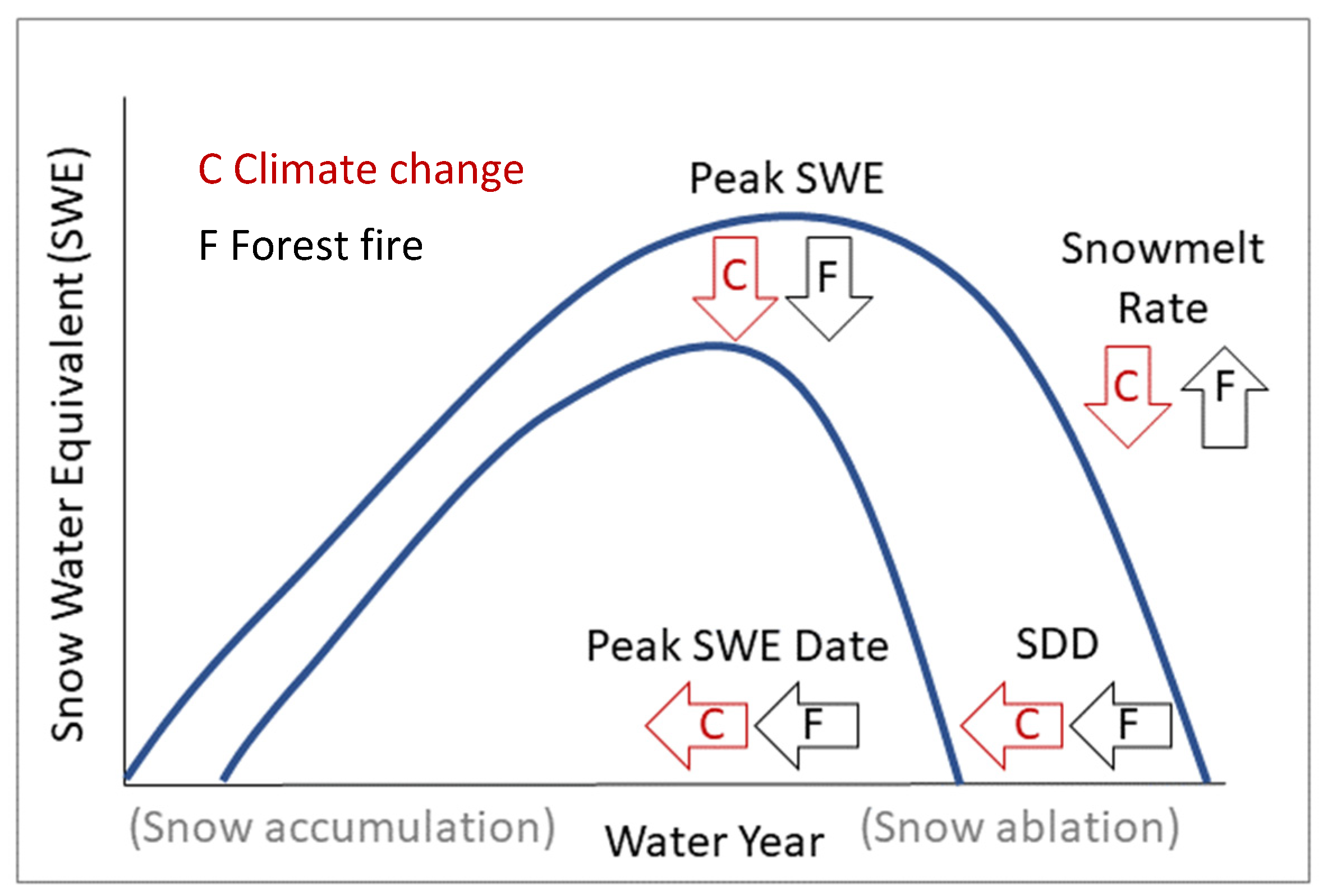
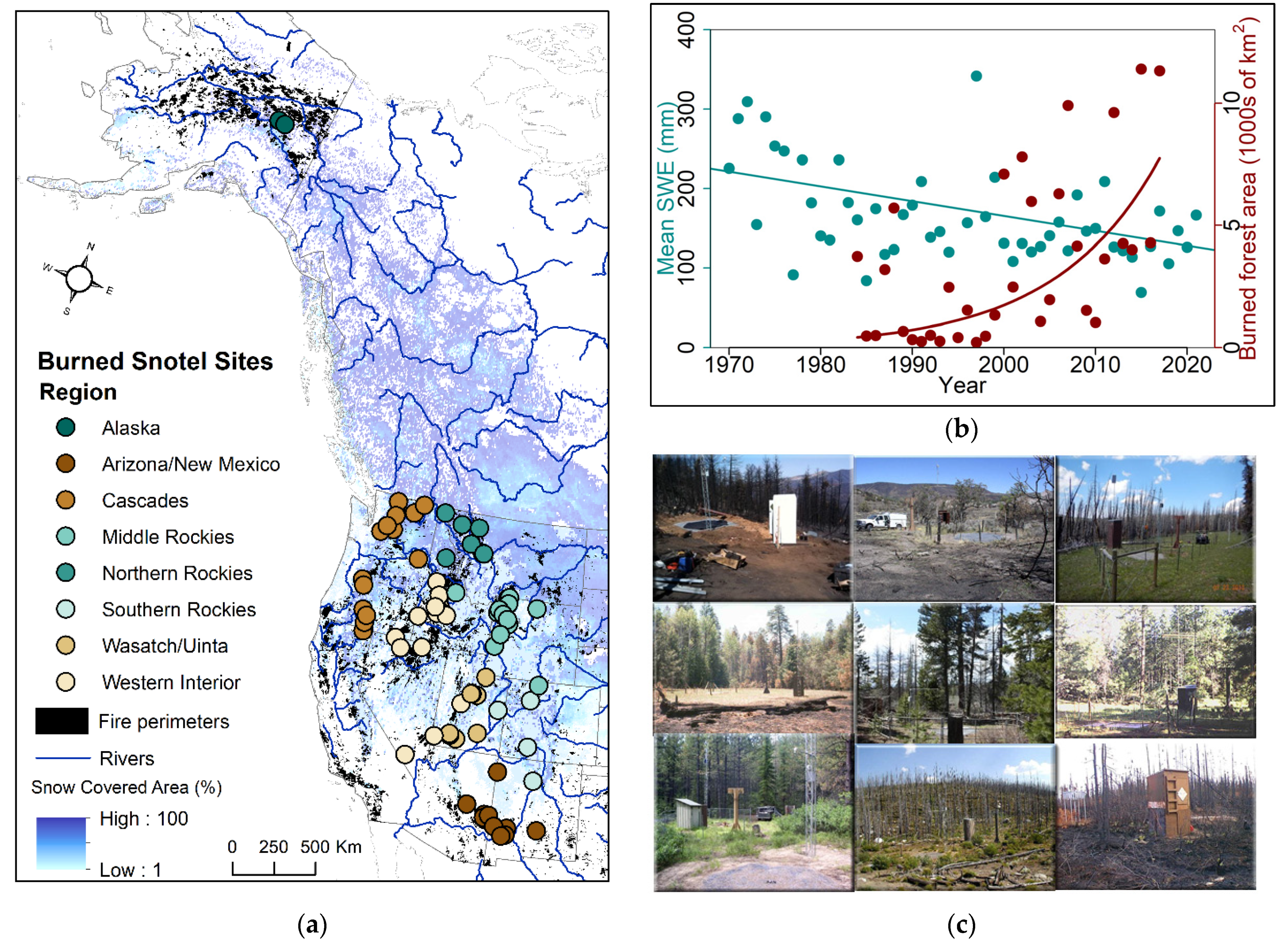

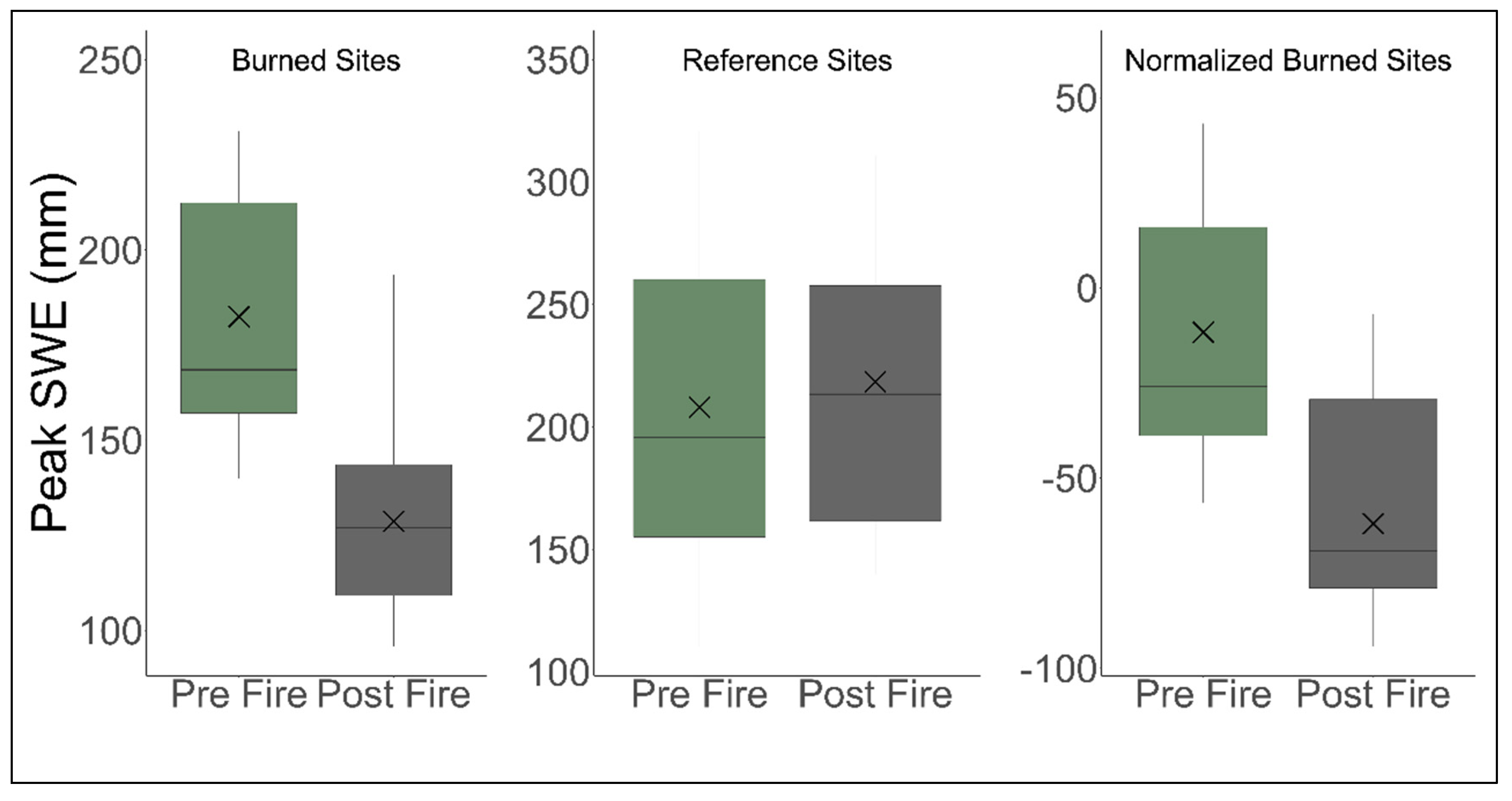
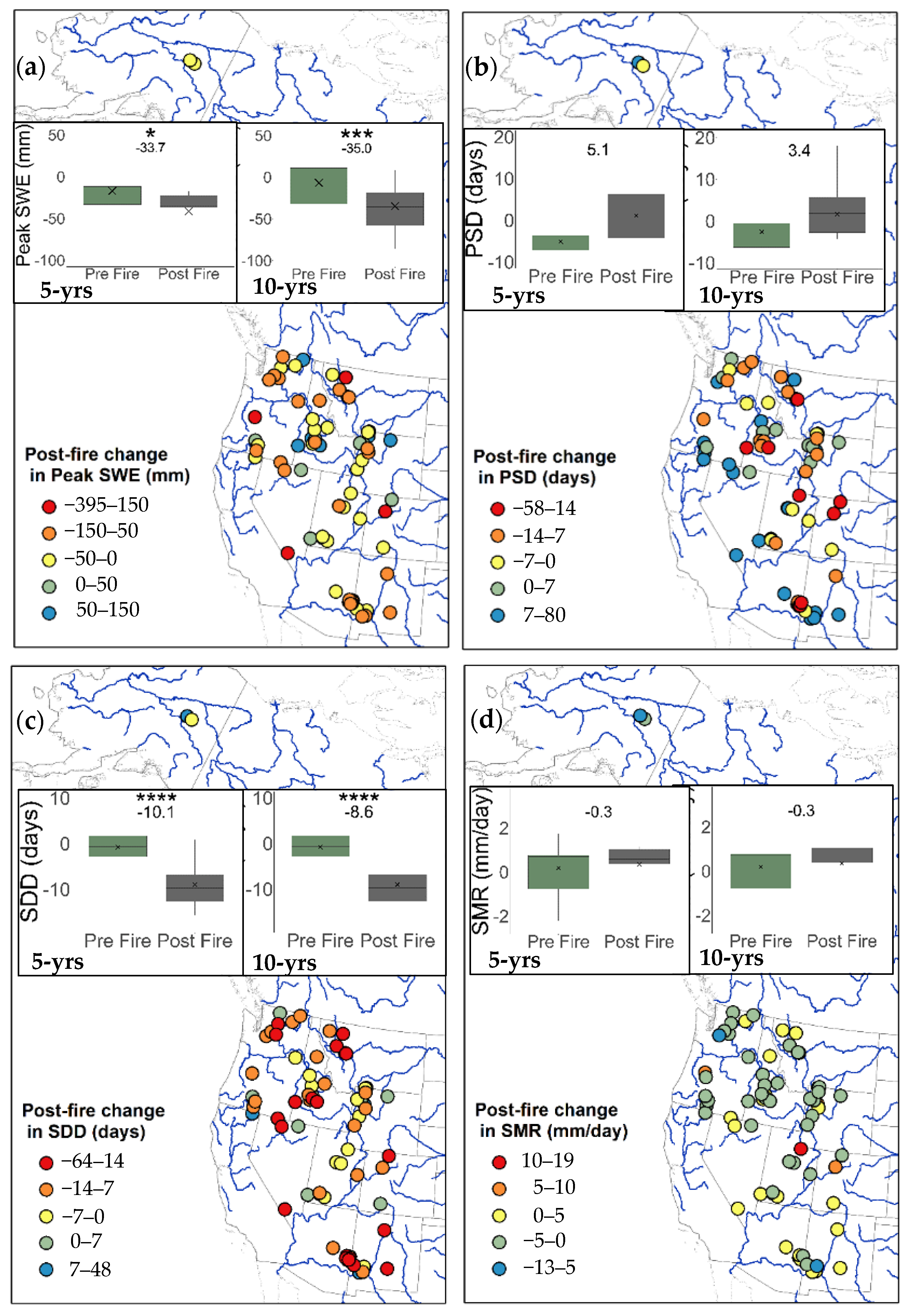
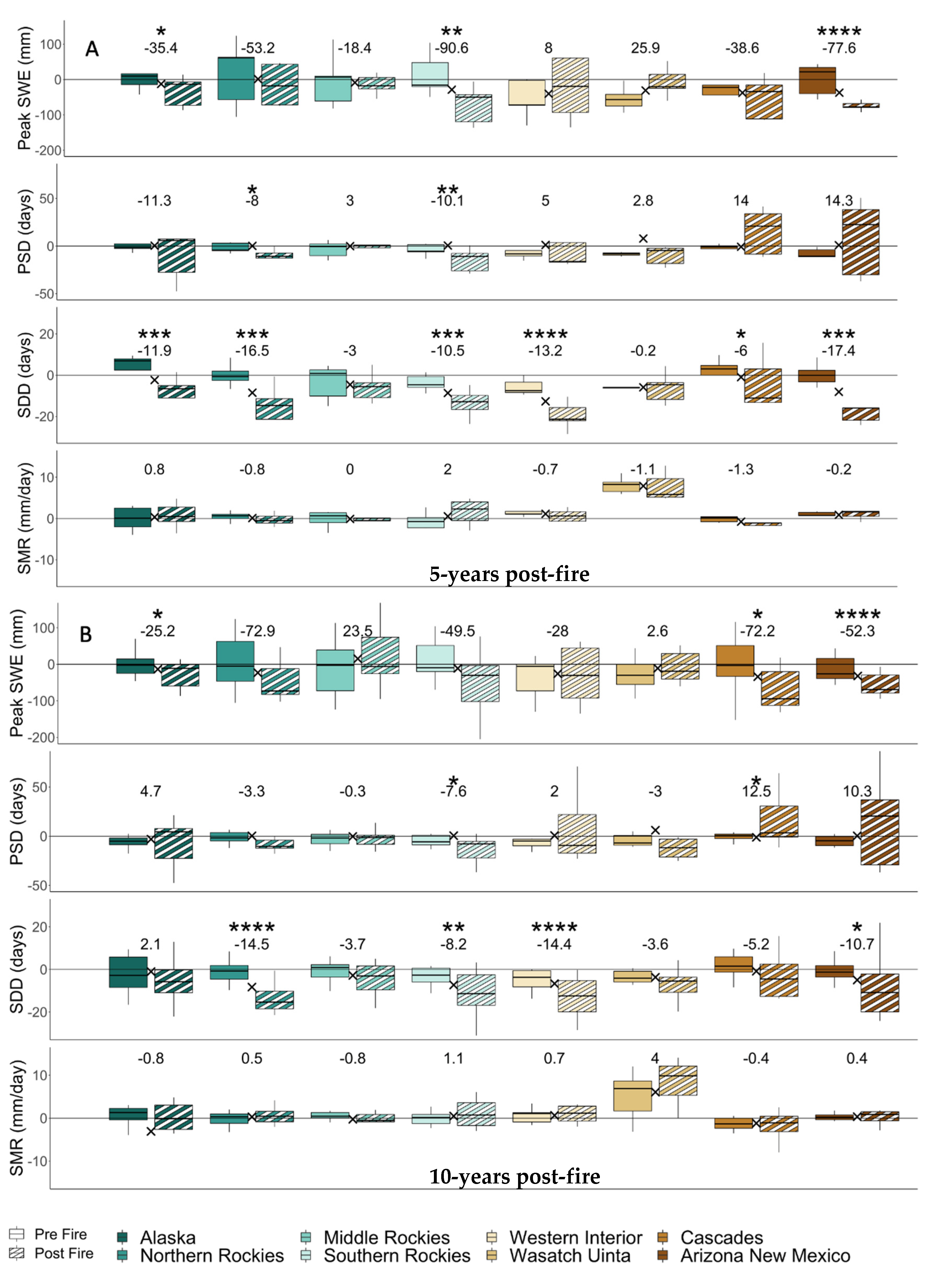
| Region | Peak SWE Date Trend (Days) | Peak SWE Trend (mm) | SDD Trend (Days) | SMR Trend (mm/Day) |
|---|---|---|---|---|
| West | −0.56 **** | −3.07 **** | −0.78 **** | 0.09 **** |
| Cascades | −0.24 * | −5.72 *** | −0.54 *** | −0.08 ** |
| North Rockies | −0.60 **** | −0.96 | −0.74 ***** | 0.01 |
| Middle Rockies | −0.24 ** | 1.28 | −0.26 ** | −0.03 |
| South Rockies | −0.70 **** | −1.34 | −0.56 ** | 0.08 * |
| West Interior | 0.48 *** | −5.82 *** | −1.00 **** | 0.10 **** |
| Wasatch Uinta | −0.60 *** | −3.35 *** | −0.46 **** | 0.70 ** |
| Arizona/New Mexico | −0.70 **** | −3.00 **** | −0.90 **** | 0.06 ** |
| Alaska | −0.59 * | 0.68 | −0.48 * | −0.17 |
Publisher’s Note: MDPI stays neutral with regard to jurisdictional claims in published maps and institutional affiliations. |
© 2021 by the authors. Licensee MDPI, Basel, Switzerland. This article is an open access article distributed under the terms and conditions of the Creative Commons Attribution (CC BY) license (https://creativecommons.org/licenses/by/4.0/).
Share and Cite
Smoot, E.E.; Gleason, K.E. Forest Fires Reduce Snow-Water Storage and Advance the Timing of Snowmelt across the Western U.S. Water 2021, 13, 3533. https://doi.org/10.3390/w13243533
Smoot EE, Gleason KE. Forest Fires Reduce Snow-Water Storage and Advance the Timing of Snowmelt across the Western U.S. Water. 2021; 13(24):3533. https://doi.org/10.3390/w13243533
Chicago/Turabian StyleSmoot, Emily E., and Kelly E. Gleason. 2021. "Forest Fires Reduce Snow-Water Storage and Advance the Timing of Snowmelt across the Western U.S." Water 13, no. 24: 3533. https://doi.org/10.3390/w13243533






